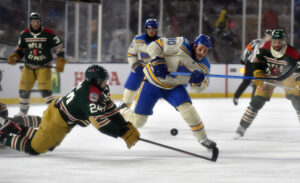Welcome back to Top Shelf Prospects, the column that brings you the next crop of professional hockey players. Each day our LWOS Prospects Writers will bring you a new player profile or topical article in the lead-up to the 2023 NHL Draft. Be sure to bookmark the site, follow Ben Kerr, Kyle Pereira and Frederik Frandson on Twitter, and spread the word for the site that will bring you analytical and critical profiles and scouting reports! Last Word On Hockey Prospects is your new headquarters for everything “NHL Draft”! Today we bring you our Ryan Leonard Scouting Report.

The 2023 NHL draft class is a loaded one. From the top with Connor Bedard and Adam Fantilli, it is arguably one of the best classes in recent memory. The USNTDP has also had a heck of a season, with some great prospects on display. One of those players is Ryan Leonard.
Ryan Leonard Scouting Report
Right Wing — shoots Right
Born January 21st, 2005 — Amherst, Massachusetts
Height 6’0″ — Weight 192 lbs [183 cm/87 kg]
Background
Leonard, born January 21st, 2005, is a forward for the US National Team Development Program. The 5’11” and 181 pound 18-year-old has played both on the wing and down the middle this season. The Amherst, Massachusetts native has scored 51 goals and 43 assists for 94 points in 57 games with the U18 program. That includes 11 goals and nine assists for 20 points in 17 USHL contests.
With his performance this season, he has been ranked between seventh and 25th, though he’s mostly landed within the top-15, amongst analysts and sites. That includes him being ranked seventh by Elite Prospects and SportsNet, ninth by Daily Faceoff, 10th by Bob McKenzie, 11th by McKeen’s Hockey, 12th by The Hockey News, DobberProspects, and Smaht Scouting, 13th by Craig Button, 14th by Recruit Scouting, 15th by Draft Prospects Hockey, and 25th by FCHockey.
Ryan Leonard Deep Dive
Despite playing on a loaded team, Leonard still shined in the form of being a near-constant top-15 staple this season. That also comes despite this year’s class being pretty excellent. But is he the one who really leads the NTDP? Or is FCHockey onto something with their ranking? Is he a product of a strong NTDP roster?
Leonard’s Skating
Leonard is a very good skater. With or without the puck, he can skate with a lot of speed. However, he does lack that extra gear that would allow him to truly burn defenders. But between his excellent first few strides that allows him to reach his speed quickly, along with his powerful lower body and balance, he can still drive the net hard. It also helps that he has a very technically sound stride, with a strong base. That adds even more to his balance and lower body power.
The one knock on his skating is his edge work. While he builds speed up well with his crossovers, it’s not often you’ll see Leonard perform tight turns or stop up quick. His game is predicated on straight line speed and acceleration in the form of quick bursts to race for pucks. It’s not like he falls way behind the play if the puck changes direction, but he falls a step behind at times, losing some speed on his turns.
Offensive Abilities
Leonard has scored a lot of goals this season. It’s easy to point to his shot being the strength of his offensive game. While that would not be the wrong idea, it’s not totally accurate. What makes Leonard such an effective goal-scorer is his ability to find space away from the puck in order to get open, as well as his willingness to get to the net-front.
But as for his shot, he can let off some bombs on a one-timer. He may not have the quickest release or the most creative, and he may not possess the most accurate shot. However, he still possesses the ability to sneak pucks just under the bar from time to time. Besides, he gets to the high-danger areas so consistently, he does not necessarily need to have a perfect shot. Besides, with some NCAA time moving forward, he can build that aspect in his game.
As for his passing and playmaking skills, he isn’t the flashiest. Leonard possesses good vision and at times can find his teammates in excellent spots and hit on some difficult passes. But for the most part, he keeps his play simple, trying to limit mistakes. As for his ability to create space for himself, he lacks in that area. Leonard does not have the best hands, and when driving to the high danger areas, he can be a bit too simple and easier to defend than coaches would like him to be. But regardless, he’s fairly well-balanced offensively. Where his value lies is his off-puck ability and willingness to battle for loose pucks. He does the dirty work, while teammates like Will Smith or Oliver Moore can do the flashy plays.
Shooting Ability
Taking a closer look at his shooting, this writer tracked three USHL games of Leonard’s. In those three games, Leonard fired eight shots at even-strength, with five hitting the net, and one finding the back of it. Of those eight shots, six came from high-danger. That included all five shots on net and the goal that he scored.
Adding the power play numbers, he had an additional five shot attempts, with three on target and two goals. Three of those five shots came from high-danger, which included his two goals. As one can decipher from these numbers, he attacks the high-danger areas consistently. But again, this is because he sets himself up there without the puck, not because he consistently works his way there by himself. That’s not a bad thing, of course, but that’s an aspect he needs to work on; creating for himself with the puck.
Playmaking Ability
As for passing stats in those three games, he had 16 offensive zone pass attempts at even-strength, with 11 of them being completed. Seven of those 16 were aimed at high-danger, where he completed two of them. Meanwhile, he completed all eight of his pass attempts at low-danger, showing his willingness to slow the game down and simplify the possession.
On the powerplay, he had 15 offensive zone pass attempts, where he completed 14 of them. He only attempted one pass at high-danger, which was not completed. Meanwhile, all 14 completions were made for low-danger. This once again shows that he doesn’t always push the pace and can slow the game down. On the power play especially, he avoided turnovers and looked to extend offensive zone attack time.
Ryan Leonard’s Transitional Abilities
Leonard is a good skater, with a high-end motor. But he does not possess the best stickhandling skills nor the creativity. Along with the fact that he plays a lot with the flashy Smith and one of Moore or Gabe Perreault, it’s unlikely he would play a large role in this area, right?
Diving Deeper Into The Transitional Numbers
Wrong. He was arguably the player who was most relied upon for exits, and had his fair share of entries as well. Starting with exits, he was directly involved in 27 exit attempts. Of those 27, they were able to successfully exit, with possession, on 19 of them (70.37% rate). That high rate of attempts is second to only Bedard (22 in three games).
As for his entries, he was involved directly in 25 entry attempts. Of those, he successfully generated 16 controlled zone entries (64% rate). He’s behind only Smith, Bedard and Zach Benson in the class, amongst players that have been tracked. What’s even more impressive is the seven rush chances he generated off of those 16 entries, which ranked second only to Bedard (10), again.
Leonard’s Defensive Zone Play
As mentioned, Leonard’s offensive game is predicated on his off-puck movement and motor. But the reason his transitional game is so good is due to his defensive game. He is uber-involved in his own end. That shows in the 22 defensive zone touches at even-strength in two tracked games (started tracking zone touches after tracking his first game). That’s an average of 11 defensive zone touches, which is first amongst the players tracked.
As for the eye test, Leonard can get a bit chaotic in his own end. Not necessarily with the puck. But he plays aggressively, attacking puck carriers and his man at the point. However, he can get out of position at times, and be caught puck chasing. There was one point where he was the weak side winger, and should have protected the low slot. Instead, he was in the corner on the other half of his zone, where two other teammates already were. Organizing his defensive game will go a long way in making him not only better transitionally, but a better two-way forward in general. His involvement and engagement is excellent, but he needs to dial it back at times.
Ryan Leonard’s Potential
Leonard is a modern day power forward. With his scoring ability and playmaking ability, his ceiling is a bit higher than that of what you’d expect from a power forward. That being said, he has the making of a first-line forward. If he can continue to build on his scoring pedigree moving forward, maybe he could reach borderline elite status.
NHL Comparison
Based only on style, and not projecting a players traits or how well a player will perform, Leonard plays a style similar to that of J.T. Miller. While Leonard does have better effort on film with the NTDP in his own end, it’s the offensive playing styles and hybrid scoring/power forward style that compares favorably. Another good comparison would be Oliver Bjorkstrand, who is also a solid goal-scorer and high motor player.
Highlights
Tracked Stats from Kyle Pereira
Raw stats via Elite Prospects
Main Photo: Eric Bolte-USA TODAY Sports






